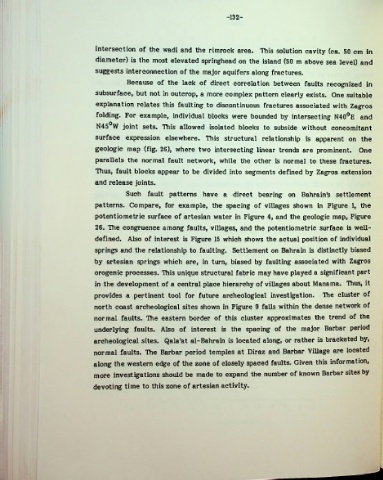Page 156 - Life & Land Use on the Bahrain Islands (Curtis E Larsen)
P. 156
-132-
intersection of the wadi and the rimrock area. This solution cavity (ca. 50 cm in
diameter) is the most elevated springhead on the island (50 m above sea level) and
suggests interconnection of the major aquifers along fractures.
Because of the lack of direct correlation between faults recognized in
subsurface, but not in outcrop, a more complex pattern clearly exists. One suitable
explanation relates this faulting to discontinuous fractures associated with Zagros
folding. For example, individual blocks were bounded by intersecting N40°E and
N45°W joint sets. This allowed isolated blocks to subside without concomitant
surface expression elsewhere. This structural relationship is apparent on the
geologic map (fig. 26), where two intersecting linear trends are prominent. One
parallels the normal fault network, while the other is normal to these fractures.
Thus, fault blocks appear to be divided into segments defined by Zagros extension
and release joints.
Such fault patterns have a direct bearing on Bahrain!s settlement
patterns. Compare, for example, the spacing of villages shown in Figure 1, the
potentiometric surface of artesian water in Figure 4, and the geologic map, Figure
26. The congruence among faults, villages, and the potentiometric surface is well-
defined. Also of interest is Figure 15 which shows the actual position of individual
springs and the relationship to faulting. Settlement on Bahrain is distinctly biased
by artesian springs which are, in turn, biased by faulting associated with Zagros
orogenic processes. This unique structural fabric may have played a significant part
in the development of a central place hierarchy of villages about Manama. Thus, it
provides a pertinent tool for future archeological investigation. The cluster of
north coast archeological sites shown in Figure 9 falls within the dense network of
normal faults. The eastern border of this cluster approximates the trend of the
underlying faults. Also of interest is the spacing of the major Barbar period
archeological sites. QalaTat al-Bahrain is located along, or rather is bracketed by,
normal faults. The Barbar period temples at Diraz and Barbar Village are located
along the western edge of the zone of closely spaced faults. Given this information,
more investigations should be made to expand the number of known Barbar sites by
devoting time to this zone of artesian activity.

